- GCN/BACODINE POSITION NOTICE
TITLE: GCN/SWIFT NOTICE
NOTICE_DATE: Mon 09 May 05 04:00:33 UT
NOTICE_TYPE: Swift-BAT GRB Position
TRIGGER_NUM: 118749, Seg_Num: 0
GRB_RA: 189.056d {+12h 36m 13s} (J2000),
189.122d {+12h 36m 29s} (current),
188.439d {+12h 33m 45s} (1950)
GRB_DEC: +29.000d {+29d 00' 01"} (J2000),
+28.971d {+28d 58' 15"} (current),
+29.275d {+29d 16' 32"} (1950)
GRB_ERROR: 4.00 [arcmin radius, statistical only]
GRB_INTEN: 784 [cnts] Peak=68 [cnts/sec]
TRIGGER_DUR: 0.128 [sec]
TRIGGER_INDEX: 122 E_range: 25-100 keV
BKG_INTEN: 34736 [cnts]
BKG_TIME: 14408.00 SOD {04:00:08.00} UT
BKG_DUR: 8 [sec]
GRB_DATE: 13499 TJD; 129 DOY; 05/05/09
GRB_TIME: 14419.23 SOD {04:00:19.23} UT
GRB_PHI: -46.92 [deg]
GRB_THETA: 7.95 [deg]
SOLN_STATUS: 0x83
RATE_SIGNIF: 9.59 [sigma]
IMAGE_SIGNIF: 6.00 [sigma]
MERIT_PARAMS: +1 +0 +0 -3 +2 +0 +0 +0 +52 +1
SUN_POSTN: 46.18d {+03h 04m 44s} +17.37d {+17d 22' 14"}
SUN_DIST: 121.45 [deg]
MOON_POSTN: 55.08d {+03h 40m 18s} +22.78d {+22d 46' 33"}
MOON_DIST: 111.92 [deg]
MOON_ILLUM: 1 [%]
GAL_COORDS: 182.90, 86.16 [deg] galactic lon,lat of the burst (or transient)
ECL_COORDS: 175.59, 29.97 [deg] ecliptic lon,lat of the burst (or transient)
COMMENTS: SWIFT-BAT GRB Coordinates.
COMMENTS: This is a rate trigger.
COMMENTS: A point_source was found.
COMMENTS: This does not match any source in the on-board catalog.
COMMENTS: This does not match any source in the ground catalog.
COMMENTS: This is a GRB.
COMMENTS: Since the IMAGE_SIGNIF is less than 7 sigma, this is a questionable detection.
- red DSS finding chart
ps-file
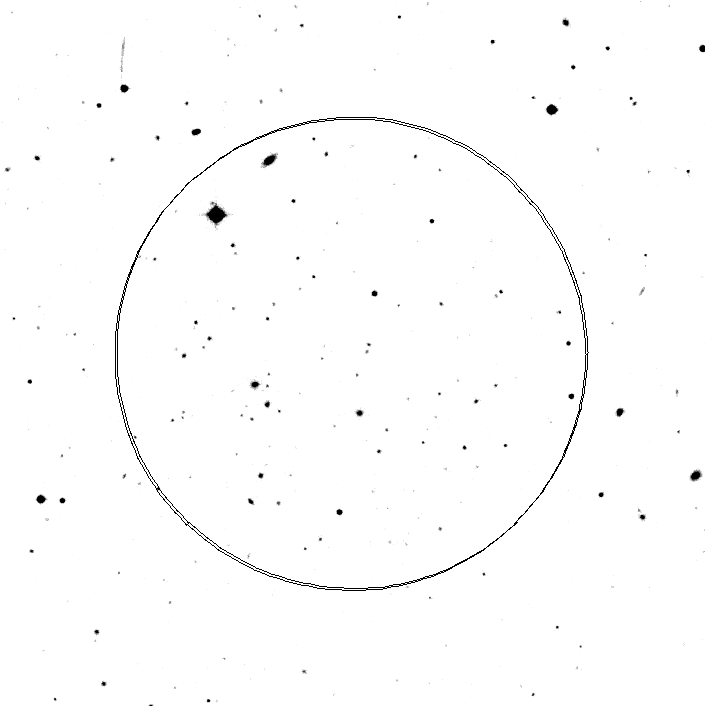
- GCN/SWIFT NOTICE
TITLE: GCN/SWIFT NOTICE
NOTICE_DATE: Mon 09 May 05 04:01:22 UT
NOTICE_TYPE: Swift-XRT Nack-Position
TRIGGER_NUM: 118749, Seg_Num: 0
POINT_RA: 189.057d {+12h 36m 14s} (J2000)
POINT_DEC: +28.994d {+28d 59' 37"} (J2000)
GRB_DATE: 13499 TJD; 129 DOY; 05/05/09
GRB_TIME: 14472.19 SOD {04:01:12.19} UT
COUNTS: 2 Min_needed= 20
STD_DEV: 0.00 Max_StdDev_for_Good=28.44 [arcsec]
PH2_ITER: 1 Max_iter_allowed= 4
ERROR_CODE: 1
COMMENTS: SWIFT-XRT Nack Position.
COMMENTS: No source found in the image.
- GCN/SWIFT NOTICE
TITLE: GCN/SWIFT NOTICE
NOTICE_DATE: Mon 09 May 05 04:04:01 UT
NOTICE_TYPE: Swift-BAT GRB Lightcurve
TRIGGER_NUM: 118749, Seg_Num: 0
GRB_RA: 189.056d {+12h 36m 13s} (J2000),
189.122d {+12h 36m 29s} (current),
188.439d {+12h 33m 45s} (1950)
GRB_DEC: +29.000d {+29d 00' 01"} (J2000),
+28.971d {+28d 58' 15"} (current),
+29.275d {+29d 16' 32"} (1950)
GRB_DATE: 13499 TJD; 129 DOY; 05/05/09
GRB_TIME: 14419.23 SOD {04:00:19.23} UT
TRIGGER_INDEX: 122
GRB_PHI: -46.92 [deg]
GRB_THETA: 7.95 [deg]
DELTA_TIME: 45.00 [sec]
LC_URL: sw00118749000msb.lc
SUN_POSTN: 46.18d {+03h 04m 44s} +17.37d {+17d 22' 14"}
SUN_DIST: 121.45 [deg]
MOON_POSTN: 55.08d {+03h 40m 18s} +22.78d {+22d 46' 33"}
MOON_DIST: 111.92 [deg]
MOON_ILLUM: 1 [%]
GAL_COORDS: 182.90, 86.16 [deg] galactic lon,lat of the pointing direction
ECL_COORDS: 175.59, 29.97 [deg] ecliptic lon,lat of the pointing direction
COMMENTS: SWIFT-BAT GRB Lightcurve.
COMMENTS: This is a rate trigger.
COMMENTS: A point_source was found.
COMMENTS: This does not match any source in the on-board catalog.
COMMENTS: This does not match any source in the ground catalog.
COMMENTS:
COMMENTS: The next comments were copied from the BAT_POS Notice:
COMMENTS: This is a GRB.
COMMENTS: Since the IMAGE_SIGNIF is less than 7 sigma, this is a questionable detection.
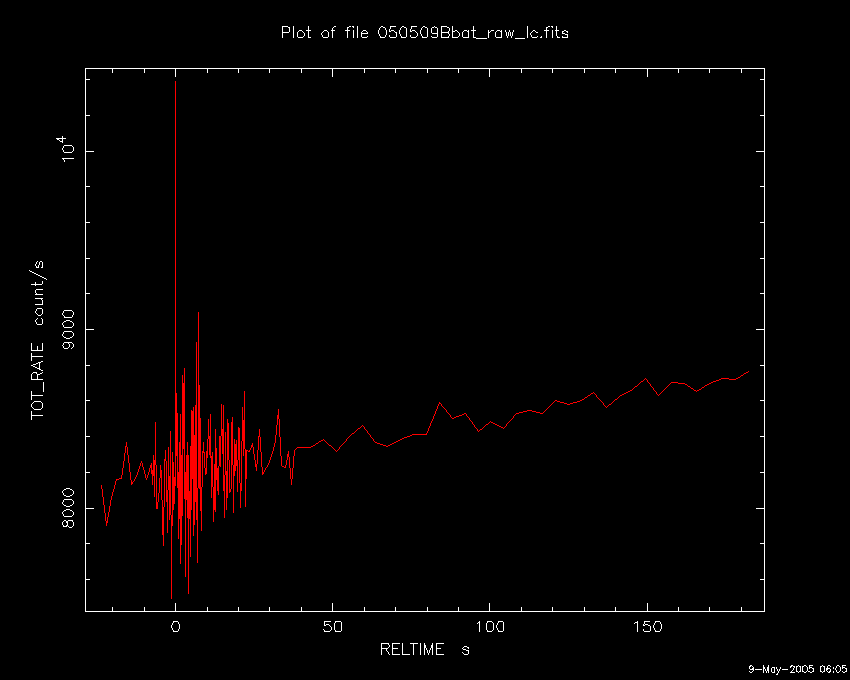
- GCN/SWIFT NOTICE
TITLE: GCN/SWIFT NOTICE
NOTICE_DATE: Mon 09 May 05 04:05:36 UT
NOTICE_TYPE: Swift-XRT Lightcurve
TRIGGER_NUM: 118749, Seg_Num: 0
POINT_RA: 189.057d {+12h 36m 14s} (J2000)
POINT_DEC: +28.991d {+28d 59' 27"} (J2000)
LC_START_DATE: 13499 TJD; 129 DOY; 05/05/09
LC_START_TIME: 14474.90 SOD {04:01:14.90} UT
LC_STOP_DATE: 13499 TJD; 129 DOY; 05/05/09
LC_STOP_TIME: 14724.13 SOD {04:05:24.13} UT
LC_LIVE_TIME: 245.58 [sec], 98.5%
DELTA_TIME: 86150.77 [sec]
N_BINS: 100
TERM_COND: 0
LC_URL: sw00118749000msx.lc
SUN_POSTN: 46.18d {+03h 04m 44s} +17.37d {+17d 22' 14"}
SUN_DIST: 121.45 [deg]
MOON_POSTN: 55.08d {+03h 40m 20s} +22.78d {+22d 46' 42"}
MOON_DIST: 111.92 [deg]
MOON_ILLUM: 1 [%]
GAL_COORDS: 183.01, 86.16 [deg] galactic lon,lat of the pointing direction
ECL_COORDS: 175.60, 29.96 [deg] ecliptic lon,lat of the pointing direction
COMMENTS: SWIFT-XRT Lightcurve.
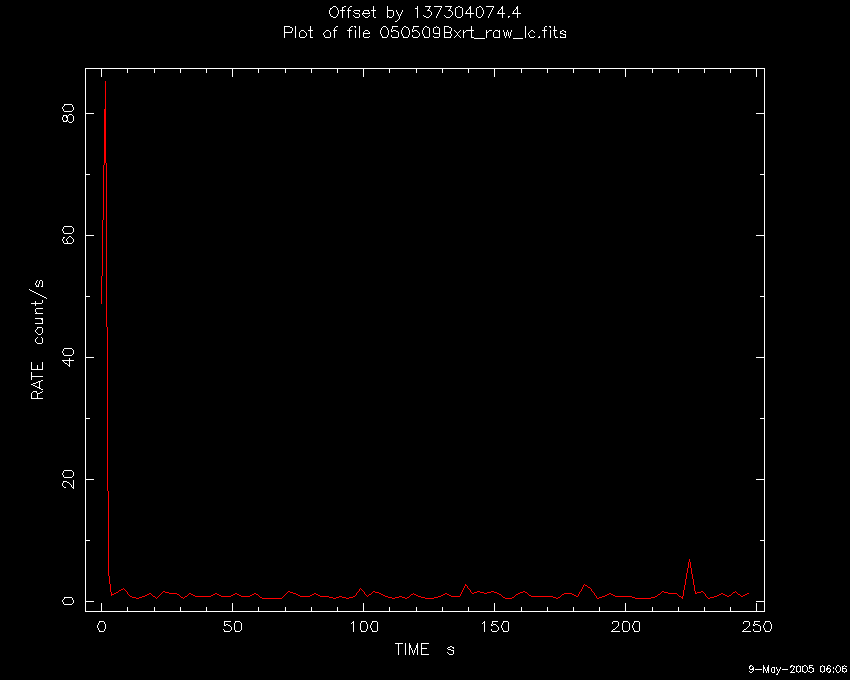
- GCN notice #3381
C. Hurkett, E. Rol, (U Leicester), L. Barbier (GSFC), S. Barthelmy (GSFC),
A. Blustin (MSSL), D. Burrows (PSU), J. Cummings (GSFC/NRC),
N. Gehrels (GSFC), J. Kennea (PSU), C. Markwardt (GSFC/UMD), S. Holland
(GSFC/USRA) on behalf of the Swift Team;
At 04:00:19.23 UT, the Swift Burst Alert Telescope (BAT) triggered and
located on-board GRB050509b (trigger #118749). The BAT on-board
calculated location is RA, dec 189.056, +29.000 (12h 36m 13s, +29d 00' 01'')
(J2000) with an uncertainty of 4 arcmin (radius, 3-sigma, including
estimated systematic uncertainty). The BAT light curve showed a single short
spike with a duration of less than 128 milliseconds. The peak
count rate measured by BAT was about 2100 counts/sec in the 15 -
350 keV band.
The Swift spacecraft slewed promptly onto the BAT position. The XRT
imaged the field at 04:01:12 (53.0 s after the burst), but did not find
any bright source in the field. An XRT position will be determined by
analysis of the full data following the next ground station pass.
The Swift Ultra Violet/Optical Telescope (UVOT) observations began at
04:01:09.8 UT, 50 seconds after the BAT trigger. The first
data taken after the spacecraft settled was a 100 sec exposure
using the V filter with the midpoint of the observation at
100 sec after the BAT trigger. Based on a preliminary comparison with the
DSS, there is a possible low significance source at RA=12:36:18,
DEC=29:01:24 which is not present in the DSS. It has a V-band
magnitude of 18.8.
- GCN notice #3383
J. A. Kennea, D. N. Burrows, J. Nousek (PSU), C. P. Hurkett, E. Rol, J.
Osborne, A. Wells (U. Leicester), N. Gehrels (NASA/GSFC), G. Chincarini
(INAF-OAB) and P. Giommi (ASDC) report on behalf of the Swift XRT team:
The Swift BAT instrument detected GRB 050509b at 04:00:19 UT on 9th May
2005 (GCN Circ 3381). The observatory executed an automated slew to the
BAT position and the XRT began taking data at 04:01:12 UT. The XRT was in
Auto state but was not able to centroid on the afterglow due to low source
intensity. From downlinked data we find a faint uncatalogued X-ray source
located at:
RA(J2000) = 12:36:13.6,
Dec(J2000) = +28:58:58.6
We estimate an uncertainty of about 6 arcseconds radius (90% containment).
This position is 61 arcseconds from the BAT position reported in GCN 3381.
This source lies 44 arcseconds from the center of the Galaxy Cluster NSC
J123610+285901. Note that this source position is 157 arcseconds from the
tentative UVOT optical afterglow counterpart reported in GCN 3381, and
therefore is not associated with that source. We cannot yet determine
whether this X-ray source is fading. Additional observations are in
progress.
- GCN notice #3384
A. de Ugarte Postigo, A.J. Castro-Tirado (IAA-CSIC Granada),
A. Eigenbrod (EPF de Lausanne), M. Jelinek, J. Gorosabel
and S. Guziy (IAA-CSIC Granada),
report:
"Following the detection by Swift-BAT of the short gamma-ray burst
GRB 050509b (Hurkett et al. GCN 3381), we have obtained
two R-band images (300s exposure time each) with the 1.2m Mercator
telescope at Roque de los Muchachos Observatory in La Palma,
starting at 04:36:02 UT (i.e. 35.88. min after the onset of
the burst). The location was observed under poor seeing conditions,
at very high airmass. We do not identify any source within
the error box provided by Swift-XRT (Kennea et al. GCN 3383) down to
magnitude 21."
This message may be cited.
- GCN notice #3385
S. Barthelmy (GSFC), L. Barbier (GSFC), J. Cummings (GSFC/NRC),
E. Fenimore (LANL), N. Gehrels (GSFC), D. Hullinger (UMD),
H. Krimm (GSFC/USRA), C. Markwardt (GSFC/UMD), D. Palmer (LANL),
A. Parsons (GSFC), T. Sakamoto (GSFC/NRC), G. Sato (ISAS),
M. Suzuki (Saitama), J. Tueller (GSFC), T. Mitani (ISAS),
F. Marshall (GSFC), T. Takahashi (ISAS)
on behalf of the Swift/BAT team:
At 04:00:19.23 UT Swift-BAT detected GRB 050509b (trigger=118749)
(GCN Circ 3381, C. Hurkett et al.). The refined BAT ground position
is (RA,Dec) = 189.073,+28.991 {12:36:18,28:59:28} +- 2.8 arcmin [deg; J2000],
(95% containment). This is 59 arcsec from the XRT position (Kennea et al.,
GNC 3383). The burst was in the fully-coded FOV. Using the event-by-event
data, the lightcurve shows a single spike with a duration of ~30msec.
Further, the hardness ratio S(50-100)/S(25-50) of ~1.5 puts this burst cleanly
in the short-hard cluster on the hardness_ratio vs duration scatter-plot.
Using a simple power-law model, the photon index of the time-averaged
spectrum is 1.5 +- 0.4. The fluence in the 15-350 keV band is
(2.3 +- 0.9) x 10^-8 erg/cm2. The 1-s peak photon flux
in the 15-350 band is (1.57 +- 0.36) ph/cm2/s.
All the quoted errors are at the 90% confidence level.
We note that location is consistant with the galaxy cluster NSC J123610+285901
which has a redshift of z=0.22, which roughly translates to a distance
of ~1 Gpc. We also note that at this distance and the observed flux,
this is is an order of magnitude farther than the 27-Dec-04 SuperFlare
event from SGR1806-20 could be seen.
- GCN notice #3386
J. Bloom (UCB), C. Blake (Harvard), J. X. Prochaska (UCSC), J. Hennawi
(UCB), M. Gladders (Carnegie), B. Koester (U Michigan) report:
"We find no new point sources at the XRT position (3380) of the GRB
050509b (3381) in RIJHK (WIYN+PAIRITEL). Based I and R imaging and JHK
imaging of the XRT position of GRB 050509b, however, there appears (to the
West of the XRT) a bright extended galaxy at ra 12:36:12.90, dec
+28:58:58.8 (J2000) (=2MASS 2MASX J12361286+2858580), with J=15.25,
H=14.46, K=14.09 mag. Although the XRT is ~10 arcsec from this galaxy, at
the photometric redshift of the cluster (z=~0.22), this is only 35 kpc
h_71^{-1} in projection. Thus, we find a plausible association of this
short burst with the outskirts a nearby, potential host galaxy.
This message may be cited.
- GCN notice #3387
A. M. Soderberg (Caltech) and D. A. Frail (NRAO) report on
behalf of the Caltech-NRAO-Carnegie collaboration:
"We observed the field of GRB050509b (GCN 3381) with the
Very Large Array at 8.5 GHz on May 9.25 UT. We do not
detect any radio sources within the XRT error region (GCN 3380).
Further observations are planned."
- GCN notice #3388
J. Bloom (UCB), C. Blake (Harvard), J. X. Prochaska (UCSC), J. Hennawi
(UCB), M. Gladders (Carnegie), B. Koester (U Michigan) and H. W. Chen
(MIT) report:
We have continued to observe GRB 050509b (GCN #3383) with the imager
on the 3.5m WIYN telescope. Under improving conditions, a 600s observation
in the sloan r band beggining at 06:05 UT revealed a apparent point source
within the XRT error circle (GCN #3383) and within the detectable light of
the nearby galaxy (GCN #3386).
A finding chart may be found at:
http://pairitel.org/grb050509b-candidate.gif
This message may be cited.
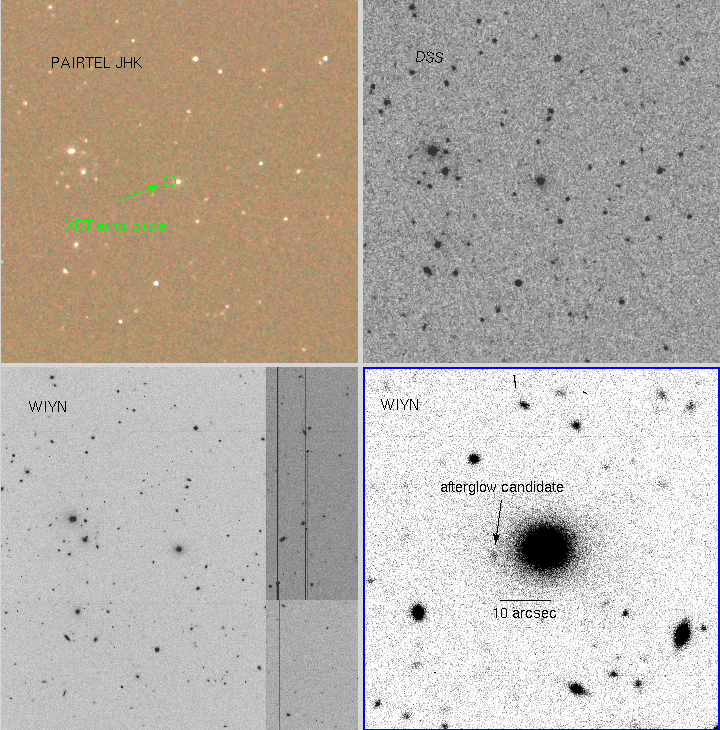
- GCN notice #3390
J. X. Prochaska (UCO/Lick), M. Cooper (UCB), J. Newman (LBNL),
J. S. Bloom (UCB), K. Hurley, (SSL/UCB), C. Blake (Harvard),
B. Gerke (UCB), and H. W. Chen (MIT) report:
"We have acquired a DEIMOS longslit spectrum of the galaxy at ra
12:36:12.90, dec +28:58:58.8 (J2000) (=2MASS 2MASX J12361286+2858580)
which is tentatively identified as the host of GRB 050509b. We measure a
redshift of z=0.226 based on Ca H and K absorption and numerous other
absorption features. We do not detect any significant emission at Hbeta,
Halpha or [O II]. The spectral features are consistent with an early
type galaxy with no ongoing star formation. If the association is
confirmed, this would be the first GRB host that is an early-type, hinting
that GRBs of short duration may be due to progenitors that are unrelated
to current and on-going star formation.
This notice may be cited."
- GCN notice #3391
S. Bradley Cenko, B. T. Soifer, Chao Bian, Vandana Desai, S. R. Kulkarni
(Caltech), Edo Berger (Carnegie), Arjun Dey and Buell T. Jannuzi (NOAO)
report on behalf of a larger collaboration:
We have imaged the error circle of the Swift GRB 050509b (GCN 3381) with
the Keck Low Resolution Imaging Spectrometer (LRIS) mounted on the Keck I
telescope. We have obtained two epochs of simultaneous imaging in the g'
and R filters. The first epoch consisted of 4 x 300 s images taken at a
mean time of approximately 7:00 UT 9 May (~ 3 hours after the burst). The
second epoch consisted of 3 x 300 s images taken approximately 1.5 hours
later.
Inside the XRT error circle, we find four sources, three of which are
marginal detections. The brightest source is located at (J2000.0):
RA: 12:36:13.7
Dec: 28:58:57.3
The source appears to brighten slightly from our first to our second
epoch. Under close inspection, it also appears to be embedded in an
extended nebular galaxy. An image can be found at:
http://www.srl.caltech.edu/~cenko/grb050509b/050509.jpg
Further observations are planned.
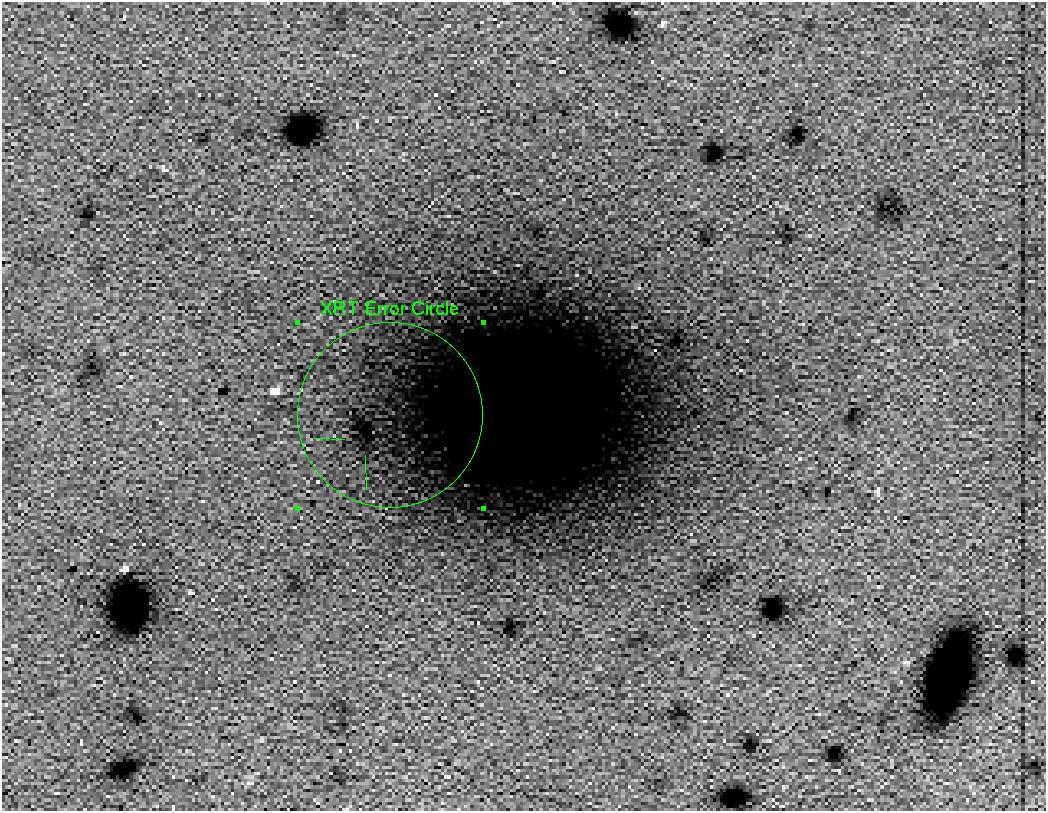
- GCN notice #3392
J. Bloom (UCB), C. Blake (Harvard), J. X. Prochaska (UCSC), J. Hennawi
(UCB), M. Gladders (Carnegie), B. Koester (U Michigan) and H. W. Chen
(MIT) report:
Connecting a WIYN 600s Sloan r band image to compact astrometric sources
in the 2MASS catalogue we find the following refined position for the
putative host (Bloom et al. GCN #3386) at redshift z=0.226 (Prochaska et
al. GCN #3390) and counterpart (Bloom et al. GCN #3388):
galaxy: RA = 12:36:12.87, Dec = 28:58:58.5
counterpart: RA = 12:36:13.67, Dec = 28:58:57.0
(J2000; absolute uncertainty of 200 milliarcsec in each direction). The
proposed counterpart is thus 1.51" S, 10.41" E from the galaxy and 1.61"
S, 0.88" E of the XRT position (Kenea et al. #3383). This distance of 1.84
arcsec is well within the astrometric uncertainty of the XRT position. The
position reported here is consistent with that reported in Cenko et al.
GCN #3391.
Another zoom in image is now posted at:
http://astro.berkeley.edu/~jbloom/grb050509b-zoom.ps
http://astro.berkeley.edu/~jbloom/grb050509b-zoom.gif
This message may be cited.
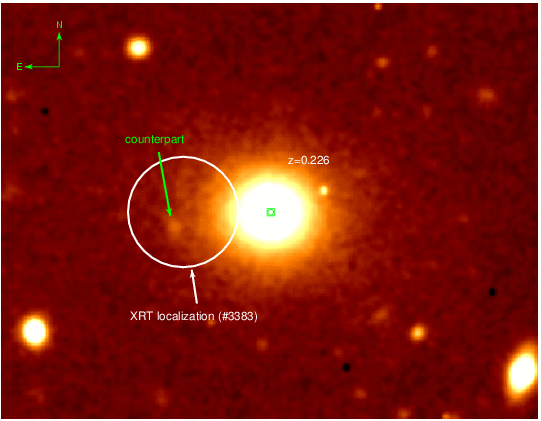
- GCN notice #3393
K. Torii (Osaka U.) reports:
"The error region of the Swift short hard GRB 050509b (Hurkett et al.
GCN 3381; Barthelmy et al. GCN 3385) was imaged with the 0.3 m
telescope in the New Mexico Skies observatory. The observation
started at 2005 May 9, 04:08:52 UT (513 s after the trigger) and 120 s
integrations in I and V bands were obtained.
The optical counterpart candidate (Bloom et al. GCN 3388; Cenko et
al. GCN 3391) of the XRT source (Kennea et al. GCN 3383) is not
detected in our frames while the candidate host galaxy is
detected. The plate scale of our images is 1".41/pixel and the optical
counterpart candidate should be readily resolved from the galaxy.
We therefore derive the following 3 sigma upper limits for the
optical counterpart candidate (GCN 3388; GCN 3391) relative to
USNO-B1.0 I magnitude.
MidTime(UT) Filter Exposure Mag
---------------------------------
04:09:52 I 1x120s >18.7
04:15:59 I 3x120s >19.2
---------------------------------
"
- GCN notice #3395
E. Rol, K. Page (Univ. of Leicester) D. N. Burrows (Penn State), N.
Gehrels (GSFC), M. Goad, C. Hurkett (Univ. of Leicester), J. Kennea (Penn
State), P
O'Brien (Univ. of Leicester) report on behalf of the Swift XRT team:
We have analyzed the Swift XRT data from the short/hard burst 050509B
(Hurkett et al. 2005, GCN 3381) using 3 orbits with a total exposure
time of 6648 seconds in Photon Counting (PC) mode, starting 62 seconds
after the trigger. The refined coordinates of the X-ray
afterglow are:
RA(J2000) = 12:36:13.9
Dec = +28:59:01
with an estimated error of 8 arcseconds (90% containment). Note that we
have increased the estimate of the error circle radius to account for
systematic variations in the centroid position for this source, which has
very few counts.
The source is detected in the first 400 seconds of PC mode at a count rate
of 0.03 counts/sec, after which it disappears below background level, and
is not seen in the data from later orbits, with an estimated decay slope
steeper than -1.
Assuming a Crab-like spectrum, we estimate an average flux level of 1e-12
erg/cm^2/s (0.3 - 10 keV), between 62 and 262 seconds after the burst
trigger. This is the faintest X-ray afterglow yet detected by Swift/XRT at
such an early time.
- GCN notice #3396
Kuntal Misra and S. B. Pandey (ARIES Naini Tal), on behalf of larger
Indian GRB collaboration
Afterglow candidate (GCN 3388) of the short duration GRB 050509B,
localized by SWIFT (GCN 3381), was monitored from ARIES Naini Tal, India
using 1-m telescope. The total exposure given in R_c band was 900sec*4 in
good sky conditions, around 11 hours after the burst. Photometry of the
stacked frame poses an upper limit of ~ 22 mag at the location of OT in
comparison to nearby USNO-A2.0 stars.
This message may be cited.
- GCN notice #3397
A. Breeveld, S. Rosen (MSSL), C. Hurkett (LU), E. Rol(LU), S. Holland (GSFC), P.
Roming (PSU), N. Gehrels (GSFC), K. Mason (MSSL), J. Nousek (PSU), on behalf of
the Swift UVOT team
Further to the initial Swift UVOT results (C. Hurkett et al. GCN 3381) we report
the results of co-added, deeper exposures of GRB 050509b with the Swift
Ultra-Violet/Optical Telescope (UVOT) on May 09, 2005.
We detect no source at the XRT determined location (Kennea et al., GCN 3383) in
any of the UVOT filters with the following 5 sigma limits in 6" radius
apertures. Because of the proximity of this position to the galaxy cluster NSC
J123610+285901 the measurements were repeated with a smaller (3.5") aperture.
The measurements are listed in the following table.
Filter Lim_Mag Lim_mag Total duration (s) T_range (s)
5sigma (6") 5sigma (3.5")
V 19.0 19.6 345 51 - 1670
B 19.7 20.3 197.4 196 - 1502
U 19.41 19.44 752.88 182 - 7642
T_range values are start and stop times between which UVOT exposures were made,
measured w.r.t the BAT trigger time (Barthelmy et al. GCN 3385).
The magnitudes are based on preliminary zero-points, measured in orbit, and will
require refinement with further calibration.
- GCN notice #3399
Jason X. Prochaska (UCO/Lick Obs.), J. S. Bloom (UCB), H.-W. Chen (MIT), &
K. Hurley (UCB) report on behalf of the GRAASP collaboration:
"We have further analyzed the longslit spectrum obtained for the candidate host
galaxy of GRB 050509b Bloom et al. GCN 3386) by Prochaska et al. (GCN 3390),
using Keck/DEIMOS. We estimate a more precise redshift of the galaxy at z =
0.2249 +/- 0.0008 by cross-correlating the spectrum with galaxy templates from
SDSS. At this redshift, the host has an intrinsic K-band luminosity of
~ 1.6 x 10^11 L_sun as derived based on its 2MASS photometry of K = 14.1 mag.
We attempt to constrain the underlying dark matter halo mass of the galaxy
based on the observed absorption line profiles. Using the Ca H&K doublet, we
estimate a velocity dispersion of ~ 340 km/sec. This corresponds to an
enclosed dynamical mass of 7.2 x 10^11 h^{-1} M_sun at the radius of the
OT r = 26.6 h^-1 kpc. The spectrum of the galaxy is presented at
http://www.graasp.org/Data/050509b
This message can be cited."
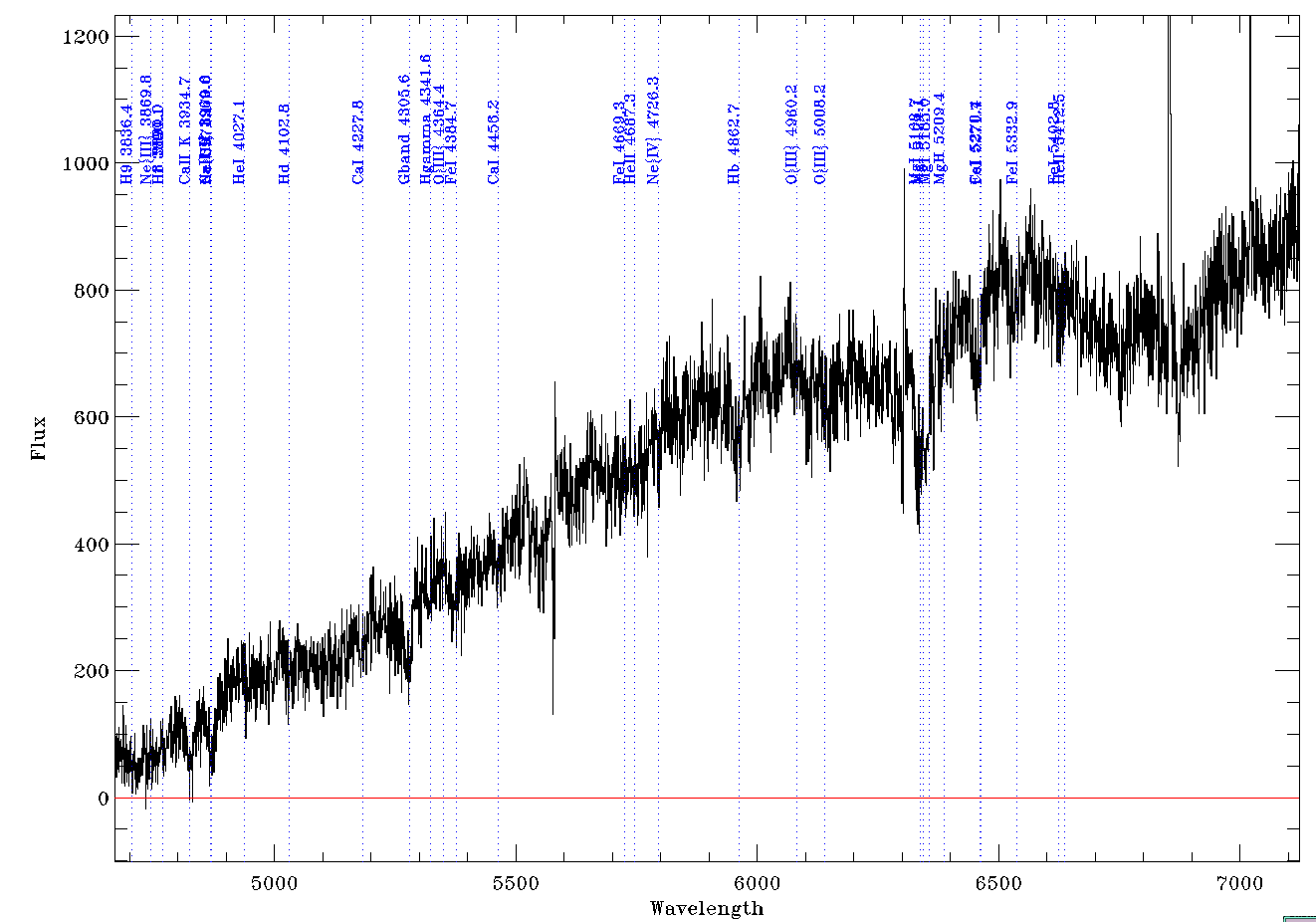 Keck/DEIMOS spectrum of the possible host galaxy. The clear identification
of Ca H and K absorption, G band absorption, and MgI sets the redshift at
z=0.225. Note the absence of Hbeta or [OIII] emission. The spectral features
suggest that this is probably an early-type galaxy. Finally, note that the
wavelength solution at wavelengths less than 4500Ang is the most uncertain
due to the absence of strong arc lamp lines.
Keck/DEIMOS spectrum of the possible host galaxy. The clear identification
of Ca H and K absorption, G band absorption, and MgI sets the redshift at
z=0.225. Note the absence of Hbeta or [OIII] emission. The spectral features
suggest that this is probably an early-type galaxy. Finally, note that the
wavelength solution at wavelengths less than 4500Ang is the most uncertain
due to the absence of strong arc lamp lines.
- GCN notice #3401
S. Bradley Cenko, B. T. Soifer, Chao Bian, Vandana Desai, S. R. Kulkarni
(Caltech), Edo Berger (Carnegie), Arjun Dey and Buell T. Jannuzi (NOAO)
report on behalf of a larger collaboration:
Further to our GCN 3391 we obtained an additional LRIS image in g and R
band. The sum of these three epochs centered on the fading X-ray source
(GCN 3395) is shown at
http://www.srl.caltech.edu/~cenko/grb050509b/050509b_zoom.jpg
In addition to the elliptical galaxy discussed in GCN 3386, there
are four sources listed below.
------------------------------------------------------------------------
Source RA (J2000.0) Dec (J2000.0) Dist from X-ray source
------------------------------------------------------------------------
S1 12:36:13.7 28:58:57.3 4.5"
S2 12:36:14.1 28:58:59.6 3.0"
S3 12:36:14.0 28:59:01.5 1.4"
S4 12:36:13.7 28:59:02.5 3.0"
Source S1 was proposed as a candidate by its proximity to the
elliptical galaxy (GCN 3388) and by its possible variability (GCN 3391).
However, as noted earlier and now confirmed with more data, source S1
is clearly extended. The color and a low resolution (LRIS) spectrum of
S1 show it to be a blue object. A simple interpretation of the data is
that source S1 a high redshift star-forming galaxy.
The optical counterpart of the fading X-ray source has not yet been
securely identified. To this end we are undertaking detailed analysis of
the LRIS images."
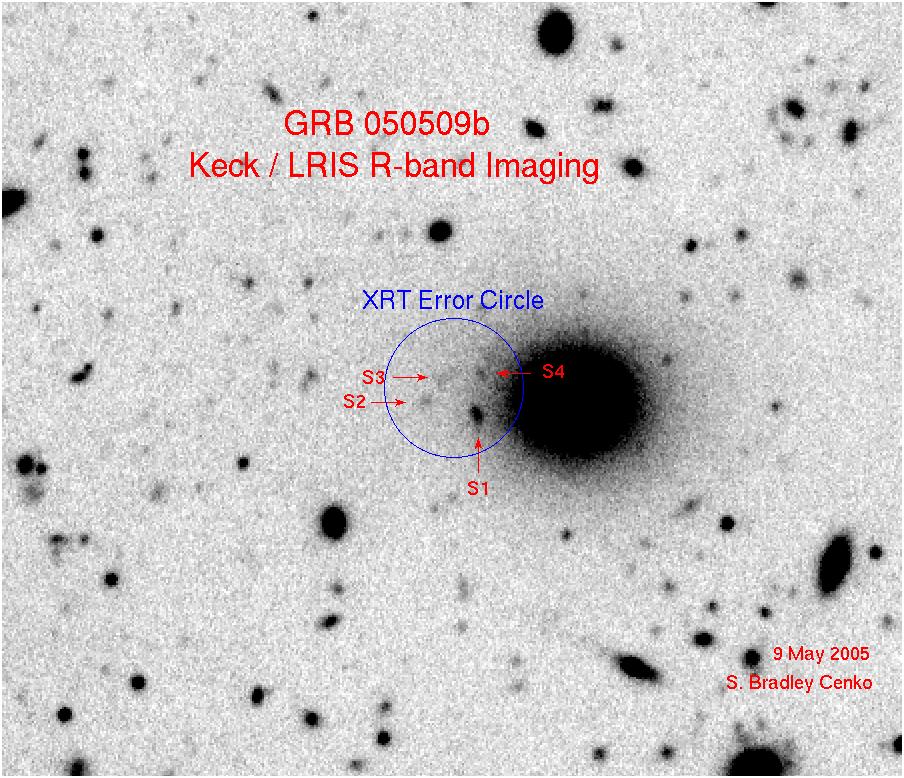
- GCN notice #3405
A.J. van der Horst, K. Wiersema and R.A.M.J. Wijers (University of
Amsterdam) report on behalf of a larger collaboration:
"We observed the position of the GRB 050509B afterglow at 4.9 GHz with the
Westerbork Synthesis Radio Telescope at May 9 14.59 UT to May 10 2.59 UT,
i.e. 10.98 - 22.98 hours after the burst (GCN 3381). We do not detect a
radio source within the SWIFT/XRT error circle (GCN 3395), in particular
at the position of the four optical sources mentioned in GCN 3401.
The rms noise in het map within the SWIFT/XRT error circle is 22 microJy
per beam. The formal flux measurement for a point source at the center of
the SWIFT/XRT error circle is 3 +/- 22 microJy.
We detect a point source coincident with the position of the center of the
galaxy observed in the optical (GCN 3390), with a peak flux of 324 +/- 22
microJy."
This message may be cited.
- GCN notice #3409
S. Bradley Cenko, B. T. Soifer, Chao Bian, Vandana Desai, S. R. Kulkarni
(Caltech), Brian P. Schmidt (ANU), Arjun Dey and Buell T. Jannuzi (NOAO)
report on behalf of the Caltech-NRAO-Carnegie GRB collaboration:
We have continued to image the field of GRB 050509b with the Low
Resolution Imaging Spectrometer mounted on the 10-m Keck I telescope. Our
latest observations consisted of 3 x 300 s images simultaneously in the g'
and R filters. The mean epoch of these observations was approximately
5:56 UT 10 May (25.8, 25.9, and 26.0 hours after the burst, respectively).
We stacked all the R-band images obtained on 9 May (GCNs 3391, 3401) and
differenced this from the stack obtained on 10 May. Adopting the value of
R = 18.5 for the USNO-A2 star located at RA 12:36:19.970, Dec +29:00:36.31
(J2000.0), we find no variation within the revised XRT error circle (GCN
3395) to a limiting magnitude of R = 25.6. Specifically for the extended
source in the XRT error circle (S1 in GCN 3401), we find this object has
not varied by more than +/- 0.18 magnitudes from 9 May to 10 May.
It is therefore unlikely that any of the 4 sources identified in GCN 3401
is the optical afterglow of GRB 050509b.
- GCN notice #3410
GRB 050509B: Optical observations at the Very Large Telescope
J. Hjorth, J. Sollerman, B. L. Jensen, J. P. U. Fynbo, P. Jakobsson,
J. M. Castro Cer=F3n, K. Pedersen, H. Pedersen, D. Watson (Niels Bohr
Institute), R. Starling (Amsterdam), J. Gorosabel (IAA-CSIC Granada),
E. Ramirez-Ruiz (IAS, Princeton), C. Kouveliotou (NASA/MSFC) on behalf
of GRACE, report :
"Using FORS2 on the 8.2m Antu Telescope at ESO/Paranal we have obtained
45 min R-band imaging (FWHM~0.7") of the XRT error circle for GRB
050509B (Swift trigger 118749, GCN 3381) at a mean epoch of May 11.0 UT.
In the revised XRT error-circle (GCN 3395) we detect the four sources
(S1-S4) mentioned in GCN 3401. None of these sources show pronounced
variability with respect to the image posted in GCN 3401. The source
previously designated S3 seems to be resolved into two sources separated
by 1.8", or a new source is apparent in the centre of the error circle.
The position of this source is:
S5:
RA(2000) =3D 12:36:13.88, Dec(2000) =3D +28:59:01.0
Another object is included just within the revised 90% XRT error-circle.
The coordinates of this object is:
S6:
RA(2000) =3D 12:33.13.63, Dec(2000) =3D +28:59:07.7
An image of the field is shown at:
http://www.astro.ku.dk/~brian_j/grb/grb050509B/
We plan to monitor the field with the VLT in the following weeks.
We thank the Paranal Observatory staff, in particular Chris Lidman and
Jura Borissova, for efficiently conducting the reported service-mode
observations."
- GCN notice #3411
Pablo Saz Parkinson (UC Santa Cruz) on behalf of the Milagro collaboration
reports:
We have searched Milagro data for emission at GeV/TeV energies from GRB
050509b (GCN Circ 3381, C. Hurkett et al.), during the burst duration
(30 ms) reported by the Swift team (GCN Circ 3385, S. Barthelmy et al.).
No evidence for prompt GeV/TeV emission was found. A preliminary analysis,
assuming a differential photon spectral index of -2.4, gives an upper
limit on E^2dN/dE at 99% confidence of:
E^2dN/dE at 2.5 TeV < 5.4 * 10^(-8) erg cm^(-2) (No EBL absorption assumed)
The spectrum of the host galaxy of the proposed afterglow of GRB 050509b
implies a redshift of 0.225 (GCN Circ 3386, J. Bloom et al., GCN Circ
3392, J. Bloom et al.). We expect that TeV photons will be attenuated by
pair production with infrared photons in intergalactic space so we also
calculate upper limits assuming different extragalactic infrared
background light (EBL) absorption models, a "fast evolution" model by
Stecker & de Jager 1988 (A&A, 334, L85) and a model by Primack et al.
2004 (AIP Conf. Proc. 745, p. 23). We find 99% confidence level upper
limits on E^2dN/dE of:
E^2dN/dE at 150 GeV < 5.5 * 10^(-7) erg cm^(-2) (Stecker et al. EBL model)
E^2dN/dE at 300 GeV < 2.0 * 10^(-7) erg cm^(-2) (Primack et al. EBL model)
The energies quoted represent the median energy of the events that would
be detected assuming a power law spectrum with differential index -2.4
convolved with each of the absorption models. These upper limits are
preliminary and will be refined with further analysis.
___________________________________________________________
Santa Cruz Institute for Particle Physics (SCIPP)
University of California, Santa Cruz
Natural Sciences II, Room 313
1156 High Street, Santa Cruz, CA 95064
Phone: (831) 459-4870
Fax: (831) 459-5777
- GCN notice #3412
A. Breeveld (MSSL), T. Poole (MSSL), E. Rol(LU),
M. Ivanushkina (PSU), S. Rosen (MSSL), M. Still (GSFC),
P. Roming (PSU), N. Gehrels (GSFC), K. Mason (MSSL),
J. Nousek (PSU), on behalf of the Swift UVOT team
Further to the initial Swift UVOT results (C. Hurkett
et al. GCN 3381 and A. Breeveld et al. GCN 3397) we report
the results of co-added, deeper exposures of GRB 050509b
with the Swift Ultra-Violet/Optical Telescope (UVOT) in
the 21 hours following the burst on May 09-10, 2005.
We detect no source at the refined XRT determined
location (12:36:13.9,28:59:01; E. Rol et al., GCN 3395)
nor in the location of the extended source S1 (12:36:13.7,
28:58:57.3; S. Bradley Cenko et al. GCN 3391) in any of
the UVOT filters. The 3-sigma limiting magnitudes are
listed in the following table for the XRT position
(XRT_Lim_Mag) and the S1 position (S1_Lim_Mag). A 6"
aperture was used in all cases.
Filter XRT_Lim_Mag S1_Lim_Mag Total Exp (s) T_range (s)
V 21.1 21.1 5213 50 - 71553
B 21.8 21.8 4696 196 - 69818
U 21.8 21.8 5070 182 - 76713
UVW1 22.3 22.2 6491 169 - 76511
UVM2 22.2 22.2 6493 154 - 75603
UVW2 22.7 22.6 5596 212 - 70726
T_range values are start and stop times between which UVOT
exposures were made, measured w.r.t the BAT trigger time
(Barthelmy et al. GCN 3385).
The magnitudes are based on preliminary zero-points,
measured in orbit, and will require refinement with further
calibration.
- GCN notice #3413
S. Covino, G.L. Israel, L.A. Antonelli, D. Malesani, A. Melandri, N.=20
Masetti, G. Tagliaferri, on behalf of the MISTICI and CIBO=20
collaborations report:
"On May 11, we observed the revised error circle of SWIFT-XRT (GCN=20
3395) of the short GRB 050509B (Hurkett et al. GCN 3381) with DOLORES=20
at the TNG (La Palma) and with=A0 FORS2 and NACO at the VLT (Chile). We=20=
collected R band photometry with FORS2 (a total of 45 minutes of=20
exposure with ~0.8 seeing), R band photometry with DOLORES ( a total of=20=
3600 s with ~1.5" seeing) and H band photometry with NACO (a total of=20
1800 s with ~0.7" seeing).
All sources mentioned in GCN 3401 (Bradley et al.) and GCN 3410=20
(Hjorth et al.) are detected with no clear sign of variability. Further=20=
observations in the nexts days are planned."
This message may be quoted.=
- GCN notice #3414
P. Wozniak, W.T. Vestrand, J. Wren, S. Evans, and R. White,
on behalf the RAPTOR team at Los Alamos National Laboratory
The RAPTOR-S telescope at Los Alamos National Laboratory responded to
Swift trigger 118749 (Hurkett et al. GCN 3381) and collected a series of
113 unfiltered images starting at 26.57 s and continuing for the first
90 minutes after the trigger. The exposure durations are 10 s for the
first 10 images, 30 s for the next 10 images and 60 s for the remaining
93 images.
Using difference imaging techniques, comparing individual images as well
as stacks of images, we have placed limits on early time variability at
the locations of sources S1-S4 (Cenko et al. GCN 3401) within the XRT
error circle (Rol et al. GCN 3395). We find no evidence for transient
emission at the four candidate locations with the following 5 sigma
limits.
time of mid limiting # of effective t-t_trig t-t_trig UT
exp. (s) mag (R) images duration start (s) end (s) start
(5 sigma)
31.6 18.8 1 10.0 26.6 36.6 04:00:45.8
193.9 20.0 10 100.0 26.6 220.4 04:00:45.8
395.3 20.8 10 300.0 234.0 629.3 04:04:13.3
1399.5 21.7 20 1200.0 642.9 2042.4 04:11:02.1
1402.7 21.8 19 1140.0 2052.9 3455.6 04:34:32.1
1399.8 21.6 19 1140.0 3466.0 4865.8 04:58:05.2
The conversion of our unfiltered PSF fluxes to R-band magnitudes was
performed using measurements of 10 nearby comparison stars from the USNO
B1.0 catalog. Sample RAPTOR-S images will be posted at
http://www.raptor.lanl.gov/images/GRB050509/grb050509_raptorS.gif
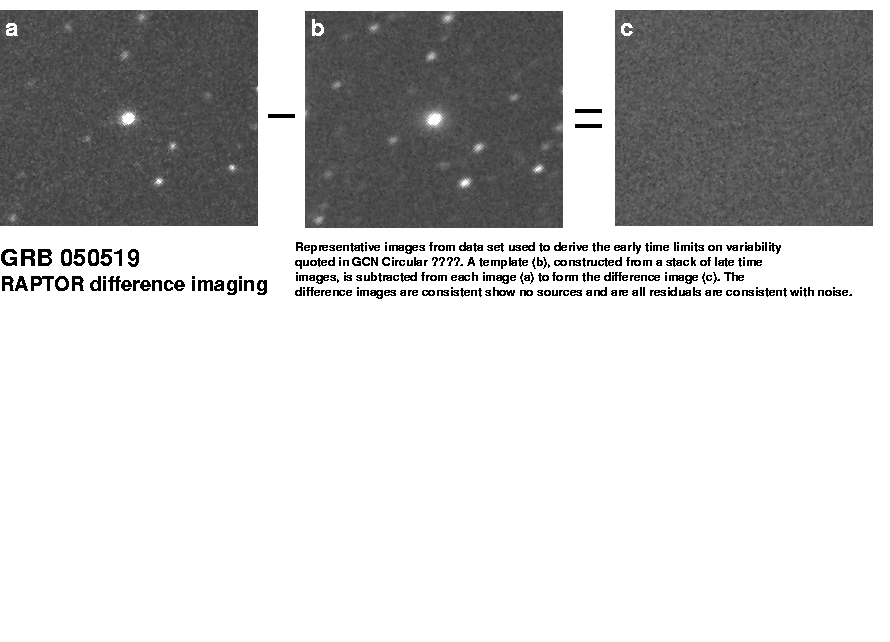
- GCN notice #3415
D. N. Burrows, D. Grupe (PSU), C. Kouvelioutou, S. Patel (MSFC), N. Gehrels
(GSFC), P. Meszaros (PSU), B. Zhang (UNLV), and R. Wijers (U. Amsterdam)
report:
We have observed the field of the short burst GRB 050509b (Hurkett et al. 2005,
GCN 3381) with the Chandra ACIS instrument. The 50 ks observation was centered
at the Swift XRT afterglow position reported by Kennea et al. (2005; GCN 3383).
Within the ACIS S3 detector 20 point sources are found by XIMAGE in our
preliminary analysis. Two of these sources fall within the revised 8 arcsecond
radius error circle reported by Rol et al. (2005; GCN 3395). The coordinates
and count rates of these sources are:
#5: 12 36 14.0 +28 59 02.5 2.46E-04+/-8.6E-05
#8: 12 36 13.9 +28 59 07.9 1.94E-04+/-7.8E-05
Source #5 is 2.0 arcseconds from the revised XRT position and is tentatively
identified as the X-ray afterglow. However, the source intensity is too low for
us to to verify whether this source is fading during our observation.
Assuming a Crab-like spectrum absorbed by galactic NH (1.5E20),
this count rate corresponds to a flux of 1.6E-15 cgs (0.2-10 keV).
Combined with the Swift XRT flux measurement at early times, we estimate a
power-law decay index of approximately -1.0 over the 200 ks interval between
the two observations. Confirmation of this afterglow candidate will require
additional Chandra observations to see whether any of these sources are fading.
- GCN notice #3416
J. S. Bloom, R. J. Foley, D. Pooley, A. V. Filippenko, R. Chornock (UCB),
C. Blake (Harvard), J. X. Prochaska (UCSC), J. Hennawi (UCB), M. Gladders
(Carnegie), B. Koester (U Michigan) and H. W. Chen (MIT) report:
We observed the field of GRB 050509b (#3383,#3385) with Keck I (+LRIS)
with g' and R filters. Starting at 20050511.25 UT, we took 5 dithered
images in each band for a total of 1660 and 1620 sec exposures in g and R,
respectively. At the location of the two reported Chandra sources we find
no significantly-detected flux in either band, however there are
indications of an R counterpart (at the few sigma level) to Chandra#8.
Moreover, these images do reveal a number of sources in the XRT fainter
than reported deep imaging with the VLT (3410) and Keck II (3401), which
we label J1-J4:
J1 12:36:13.56 +28:59:03.4
J2 13.44 04.7
J3 13.41 58:56.3
J4 13.47 59:06.2
(J2000; estimated errors of 0.3 arcsec in each direction).
We note that S5, which is less than 2 arcsec from the Chandra source #5,
appears bluer than neighboring S3 and S2.
The finding chart can be found at:
http://astro.berkeley.edu/~jbloom/grb050509b-chandra-keck-combo.gif
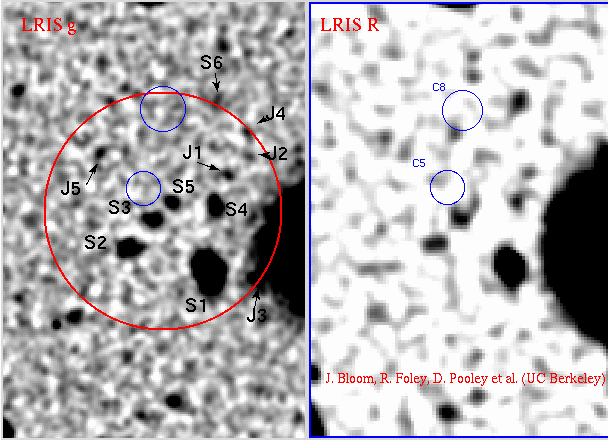
- GCN notice #3417
Correction: in GCN circular #3416 we inadvertently left out reference to
the Chandra observations (Burrows et al. #3415). Below is the corrected
circular. We apologize for the reference omission.
---------------------------
J. S. Bloom, R. J. Foley, D. Pooley, A. V. Filippenko, R. Chornock (UCB),
C. Blake (Harvard), J. X. Prochaska (UCSC), J. Hennawi (UCB), M. Gladders
(Carnegie), B. Koester (U Michigan) and H. W. Chen (MIT) report:
We observed the field of GRB 050509b (#3383,#3385) with Keck I (+LRIS)
with g' and R filters. Starting at 20050511.25 UT, we took 5 dithered
images in each band for a total of 1660 and 1620 sec exposures in g and R,
respectively. At the location of the two reported Chandra sources (Burrows
et al. GCN #3415) we find no significantly-detected flux in either band,
however there are indications of an R counterpart (at the few sigma level)
to Chandra #8. Moreover, these images do reveal a number of sources in the
XRT error circle fainter than in reported deep imaging with the VLT
(#3410) and Keck I (#3401), which we label J1-J4:
J1 12:36:13.56 +28:59:03.4
J2 13.44 04.7
J3 13.41 58:56.3
J4 13.47 59:06.2
(J2000; estimated errors of 0.3 arcsec in each direction).
We note that S5, which is less than 2 arcsec from the Chandra source #5,
appears bluer than neighboring S3 and S2.
The finding chart can be found at:
http://astro.berkeley.edu/~jbloom/grb050509b-chandra-keck-combo.gif

- GCN notice #3418
Daniel J. Eisenstein (Arizona), David W. Hogg (NYU), and Nikhil
Padmanabhan (Princeton) report on behalf of the Sloan Digital Sky Survey
(SDSS) Collaboration:
The Sloan Digital Sky Survey imaged the region of GRB 050509b on Dec 15,
2004 (MJD 53354.48, 145 days before the burst trigger). These data will
be part of a future SDSS data release, but as they should be useful as
a pre-burst comparison image and for calibrating photometry, we are
supplying the images and photometry measurements for this GRB field.
SDSS spectroscopy has not yet been performed here.
Data from the SDSS is being placed at
http://www.sdss.org/dr3/products/value_added/grb050509b/
These include 5 FITS images, 3 JPGs, and 2 files of photometry and
astrometry.
We supply FITS images in each of the 5 SDSS bands of a 8'x8' region
centered on the BAT position (ra=189.073, dec=28.991; Barthelmy et
al. GCN 3385), as well as 3 gri color-composite JPGs (with different
stretches). The units in the FITS images are nanomaggies per pixel.
A pixel is 0.396 arcsec on a side. A nanomaggie is a flux unit equal
to 10^-9 of a magnitude 0 source or, to the extent that SDSS is an AB
system, 3.631e-6 Jy. The FITS images have WCS astrometric information.
The cluster NSC J123610+285901 (Gal et al., AJ, 125, 2064, 2003) is
clearly visible in the JPGs.
The bright galaxy close to the XRT error circle (ra=189.0537, dec=28.9830)
has SDSS photometry of r_Petrosian = 17.18 +- 0.02 mag and model colors
of u-g = 1.78 +- 0.13 mag, g-r = 1.42 +- 0.02 mag, r-i = 0.52 +- 0.01,
i-z = 0.35 +- 0.02 mag. The galaxy is selected by both the Luminous
Red Galaxy and Main galaxy sample targeting algorithms, and at z=0.225
(Prochaska et al. GCN 3390 & 3399), this is a rather luminous galaxy.
Using the r-band Petrosian magnitude, we compute a rest-frame g-band
luminosity M_g = -21.90, applying evolution corrections to z=0.3
(not z=0! see Zehavi et al. ApJ, 621, 22, 2005 for an explanation).
This is about 1.5 magnitudes brighter than L* (Blanton et al., ApJ, 582,
819, 2003). The comoving number density of galaxies more luminous than
this is only about 2x10^-5 h^3 Mpc^-3. This is all in keeping with the
large velocity dispersion reported by Prochaska et al. (GCN 3399).
A posteriori statistics are always suspicious, but we note that the sky
density of galaxies this bright is about 40 per square degree, while
that of galaxies this luminous at z<0.3 is about 1 per square degree.
These are far smaller than 40,000 deg^-2, the inverse of the area of a
10 arcsecond circle. Hence, the chance association with a low-redshift
galaxy is unlikely (at the 10^-3 level), although unless additional
evidence for the association is found, it will be hard to draw a firm
conclusion from this one object.
In the file grb050509b.sdss_objects.dat, we report photometry of 335
objects detected by SDSS within 4' radius of the Swift BAT position.
We have removed saturated objects and objects fainter than 23.0 in the
r-band model magnitude.
All quantities are standard SDSS photometry, meaning that they are
very close to AB zeropoints and are quoted in asinh magnitudes.
Photometric zeropoints are known to about 2% rms; photon noise can be
much worse, of course. See documentation for details. None of this
photometry is corrected for dust extinction. The Schlegel, Finkbeiner,
and Davis (1998) predictions for this region are A_u = 0.098 mag, A_g =
0.072 mag, A_r = 0.052 mag, A_i = 0.040 mag, and A_z = 0.028 mag.
SDSS astrometry is generally better than 0.1 arcsecond per coordinate.
Users requiring high precision astrometry should take note that the SDSS
astrometric system can differ from the 2MASS system used in GCN 3392;
we have not checked the offsets in this region.
See the SDSS DR3 documentation for more details: http://www.sdss.org/dr3.
These data have been reduced with the DR3 data pipelines; however, they
are not part of that data release. We cannot guarantee that the values
here will exactly match those of the data release in which these data
are included.
Moreover, the calibration of the FITS image may differ by a small amount
(~1%) from the calibration of the quoted photometry; these came from
different pipelines.
To aid with calibration of other data sets, we also report the photometry
of 90 brighter stars (r<20.5) in a wider region (0.3 by 0.2 degrees) around
the burst. These data are in the file grb050509b.sdss_calibstars.dat.
Beware that some of these stars are not well-detected in the u-band;
use the errors to monitor this.
This note can be cited, but please also cite the SDSS data release paper,
Abazajian et al. (AJ, 129, 1755, 2005), when using the data or refering
to the technical documentation.
- GCN notice #3419
S. Patel, C. Kouveliotou (MSFC), D. N. Burrows, D. Grupe (PSU), N. Gehrels
(GSFC), P. Meszaros (PSU), B. Zhang (UNLV), and R. Wijers (U. Amsterdam)
report:
Further analysis of our 50 ks Chandra observation of GRB 050509b (Burrows
et al. 2005; GCN 3415) has shown that the XRT error circle is embedded in
the diffuse X-ray emission from the cluster NSC J123610+285901. We find
that the two X-ray sources reported in GCN 3415 are due to fluctuations in
the counts from the cluster emission and are spurious. Our refined
analysis finds no Chandra point sources within the XRT error circle down to
an estimated 99% unabsorbed flux upper limit of about
1.2 x 10e-15 ergs s^-1 cm^-2 (0.5-10.0 keV; assuming galactic column density
1.52e20 cm^-2 and spectral photon index of -2).
- GCN notice #3420
Charles W. Engelbracht and Daniel J. Eisenstein (Arizona) report:
We acquired B-band imaging of the field of GRB050509b using the 90-prime
1-degree camera on the 2.3-m Bok telescope. The time of the observation
was 0500 UT May 10 (25 hours after the burst). The exposure time was 20
minutes, and the seeing was 1.7" due to wind shake. We clearly detect
the source S1 (GCN 3388, 3401) at a B-band magnitude of 23.9. We do
not find any sources in our B-band image that are not in the Hjorth et
al. JPG image (GCN 3410).
We are making the calibrated data for a 30' square region centered on
the burst available at
http://cmb.as.arizona.edu/~eisenste/grb050509b/grb050509b_B.fits.gz
The header contains WCS astrometric information, good to 0.5".
We estimate the photometric calibration at 5%. If you are using the B
band image, please send an email to deisenstein@as.arizona.edu so that
we can inform you of any revisions.
While this image is surely not as deep as the nearly contemporaneous
Keck LRIS imaging (GCN 3409), it may be useful for photometric redshifts.
The B band lies blueward of but close to the 4000A break for the cluster
at z=0.225 (Gal et al., AJ, 125, 2064, 2003; Prochaska et al., GCN 3399).
Combined with slightly redder filters (V or g), one should be able to
efficiently distinguish cluster members from higher redshift galaxies.
We remark that if the GRB is at a much higher redshift than the cluster,
then mapping of the cluster may be important for assessing the impact of
gravitational lensing on the interpretation the burst. The velocity
dispersion of 340 km/s (Prochaska et al., GCN 3399) for the large
galaxy near the XRT position (Rol et al., GCN 3395) would predict an
Einstein radius of 3.3" with a singular isothermal sphere model and an
infinitely distant source. The embedding of the galaxy in the cluster
may increase this value. Although multiple imaging remains unlikely,
there should be non-negligible magnification.
This note can be cited.
- GCN notice #3422
G. Kosugi, H. Furusawa (Subaru/NAOJ), M. Takada (Tohoku U) and
N. Kawai (Tokyo Tech) report:
"We have observed the Swift/XRT position of GRB 050509B (GCN 3381)
in V-band with SuprimeCam on the Subaru 8.2m telescope atop Mauna
Kea on the night of May 9. We obtained 600s exposure images at
08:08 UT (4.1 hr after the event) and 11:33 UT (7.5 hr after the event),
respectively. We detect the four sources (S1-S4) mentioned in GCN 3401
along with other two sources (S5, S6) in GCN 3410. In addition, another
source is detected (S7) within the XRT error circle. No apparent
variability could be observed for these sources during the two epochs.
Our first epoch image is shown at:
http://www.naoj.org/staff/george/Distribute/GRB050509B/GRB050509B.html
This message may be cited.
- GCN notice #3423
S. Dado (Technion) and A. Dar (Technion) report:
The leading scenarios for the production of short-duration GRBs involve
(a) neutron-star mergers [1] (b) super flares from SGRs (GCN 2942 and [2])
(c) gravitational collapse of neutron-stars to strange-quark stars [3] (d)
gravitational collapse of C/O white dwarfs to neutron stars (GCN 2174) and
[3]). While scenarios (a),(b) are not associated with standard optical
SNe, scenarios (c),(d) are expected to produce a standard optical SN.
In particular, in scenario (d), a bright SNIa is expected at the GRB
location with a standard rest frame optical light curves which peak around
20 days after burst with un-reddened absolute rest frame magnitudes,
Bmax~-19.47, Vmax~-19.42, Rmax~-19.42 and Imax~-19.06 (+\-0.15 magnitude).
GRB050509B (GCN 3381) is the first well localized short-duration (~30 ms)
GRB. It allows a late time search of an SN associated with a short
duration GRB. In the observer frame the expected un-reddened spectral
energy density at a frequency nu and a time t after burst is:
F(nu,t)=((1+z) [D_L(z')]^2 / (1+z')[D_L(z)]^2) Ftsn(nu',t')
where z' is the redshift of the template SNIa whose spectral energy
density is Ftsn and nu'=[(1+z)/(1+z')] nu, t'=[(1+z')/(1+z)] t.
If GRB050509B was produced in an SNIa in the galaxy cluster NSC
J123610+285901 at a redshift z~0.225 (GCN 3390), its observed V-band light
curve should peak near t=25 days after burst with Vmax~20.43+/- 0.15
(extinction in the host galaxy is not included, but Galactic extinction in
the direction of GRB 050509B, Av~0.06 [5] is included).
Despite the failures so far to detect an optical afterglow
within/near the refined XRT error circle (GCN 3395) of GRB 050509B, an SN
search within/near the burst XRT error circle, with the most powerful
telescopes such as Keck, VLT, Subaru and HST, is highly encouraged.
[1] Goodman, J, Dar, A, & Nussinov, S. 1987, ApJ, 314, L7
[2] Hurley, K., et al. 2005, astro-ph/0502329
[2] Dar, A. 1999, A&AS, 138, 505
[3] Dar, A. & De Rujula, A. 2004, Physics Reports, 405, 203
[4] Germany, L. M., et al. 2004, A&A 415, 863
[5] Schlegel, D. J.; Finkbeiner, D. P. & Davis, M. 1998, ApJ, 500, 525
- GCN notice #3424
S. Dado (Technion), A. Dar (Technion) and A. De Rujula (CERN) report:
The leading scenarios for the production of short-duration GRBs involve
(a) neutron-star mergers [1] (b) super flares from SGRs (GCN 2942 and [2])
(c) gravitational collapse of neutron stars to strange-quark stars [3] (d)
gravitational collapse of C/O white dwarfs to neutron stars (GCN 2174 and
[4]). While scenarios (a), (b) are not associated with standard optical
supernovae (SNe), scenarios (c),(d) are expected to produce a standard
optical SN. In particular, in scenario (d), a Type Ia SN is expected at the
GRB location with standard rest-frame optical light curves peaking around
20 days after burst with un-reddened absolute magnitudes [5] Bmax ~ -19.47,
Vmax ~ - 19.42, Rmax ~ - 19.42 and Imax ~ - 19.06 (+\-0.15).
GRB050509B (GCN 3381) is the first well-localized short-duration (~ 30 ms)
GRB. A SN associated with a short GRB has never been looked for
in such favorable conditions.
In the observer's frame the associated-SN expected un-reddened spectral
energy density at a frequency nu and a time t after burst is:
F(nu,t) = F'(nu',t') [1+z] [D(z')]^2 / ( [1+z'] [D(z)]^2] )
where z' is the redshift of a template Type Ia SN with spectral energy
density F'; D(z) and D(z') are luminosity distances, nu'=[(1+z)/(1+z')] nu
and t'=[(1+z')/(1+z)] t.
If GRB050509B was produced in association with a Type Ia SN in the galaxy
cluster NSC J123610+28590, at redshift z = 0.225 (GCN 3390), its rising
optical light curve should be observable well before its peak around t =
25 days after burst with Vmax ~ 20.43 +/- 0.15 (extinction in the host
galaxy is not included, but Galactic extinction in the direction of GRB
050509B, Av~0.06 [6] is included).
In spite of the non-detections of an optical afterglow near the refined
XRT error circle (GCN 3395) of GRB 050509B, a SN search in this direction,
perhaps with telescopes such as Keck, VLT, Subaru and HST, may prove
very fruitful.
[1] Goodman, J., Dar, A., & Nussinov, S. 1987, ApJ, 314, L7
[2] Hurley, K., et al. 2005, astro-ph/0502329
[3] Dar, A. 1999, A&AS, 138, 505
[4] Dar, A. & De Rujula, A. 2004, Physics Reports, 405, 203
[5] Germany, L. M., et al. 2004, A&A 415, 863
[6] Schlegel, D. J.; Finkbeiner, D. P. & Davis, M. 1998, ApJ, 500, 525
- GCN notice #3454
A. Henden (AAVSO/USNO) reports on behalf of the USNO GRB Team:
We have acquired BVRcIc all-sky photometry for 11x11arcmin
fields centered on the coordinates of recent GRB localizations
with the USNOFS 1.0-m telescope on one photometric night
but with bright moonlight. Stars brighter than V=12.0
are saturated and should be used with care. We have placed
the photometric data on our anonymous ftp site:
ftp://ftp.nofs.navy.mil/pub/outgoing/aah/grb/grb050319.dat
ftp://ftp.nofs.navy.mil/pub/outgoing/aah/grb/grb050401.dat
ftp://ftp.nofs.navy.mil/pub/outgoing/aah/grb/grb050408.dat
ftp://ftp.nofs.navy.mil/pub/outgoing/aah/grb/grb050416.dat
ftp://ftp.nofs.navy.mil/pub/outgoing/aah/grb/grb050502a.dat
ftp://ftp.nofs.navy.mil/pub/outgoing/aah/grb/grb050509b.dat
The astrometry in these files is based on linear plate solutions
with respect to UCAC2. The external errors are less than 100mas.
The estimated external photometric error is about 0.03mag.
Since these bursts had identified optical afterglows, we expect
to improve the photometric calibration on subsequent nights.
As always, you should check the dates on the .dat file prior to
final publication to get the latest photometry. There is
a README file on the ftp directory to give you information
about the procedures used to calibrate these fields.
- GCN notice #3455
V.Rumyantsev (CrAO), V.Biryukov (SAI, MSU), B. Kahharov, M. Ibrahimov, D.
Sharapov (MAO), A.Pozanenko (IKI) on behalf of larger GRB follow up
collaboration report:
We observed the refined XRT error circle (Rol et al, GCN3395) of GRB050509b
(Hurkett et al, GCN3381) with 2.6m F/3.85 Shajn telescope (ZTSh, CrAO)
equipped with FLI IMG1001E CCD camera and 1.5m telescope (Maidanak
Astronomical Observatory) on May 9 and 10. Maidanak observation took place
on May 9 (16:48 - 18:31 UT) and May 10 (16:15 - 18:20 UT) in R-band with
total exposure of 3600 sec in each date. ZTsh observation starts on May 9,
18:26 (UT) with total exposure of 3360 sec in R- and 1680 sec in I-band. The
source S1 (S. Bradley Cenko et al, GCN3391, 3401) is visible in R and I.
USNO B1.0 catalog is used for calibration and photometry of S1 source in R
and I band:
UT Telescope Exp. Band magnitude
May 9 16:48-18:31 1.5m 3600 R 22.88 +/-0.13
May 9 18:51-20:02 2.6m 1680 I 22.72 +/-0.23
May 9 18:26-21:16 2.6m 3360 R 22.79 +/-0.08
May 10 16:15-18:20 1.5m 3600 R 22.93 +/-0.18
May 9+10 1.5m 7200 R 22.92 +/-0.07
(Magnitude of the S1 may be biased due to highlighting of bright galaxy.)
Stacked images and stars used for calibration can be found in
http://grb.rssi.ru/GRB050509b.
While no variable optical source was found till now (G. Kosugi et al,
GCN3422) the data obtained may be useful for long term monitoring of S1.
This message may be cited.
- GCN notice #3494
D. N. Burrows (PSU), S. Patel (MSFC), C. Sarazin (U. Virginia), E. Rol, M.
R. Goad, P. T. O'Brien, R. Willingale (U. Leicester), and N. Gehrels (GSFC)
report:
Motivated by Bloom et al. (astro-ph 0505480), the Swift XRT team has
reviewed our analysis of the XRT position for GRB 050509b (Rol et al., GCN
3395). We have taken into account the low counting statistics, cluster
emission in the field and astrometric corrections. In order to evaluate
possible cluster contributions, we
have tested a variety of aperture sizes and time intervals. We find that
the cluster emission contributes no more than 1 photon (on average) to the
counts detected within any of our temporal and spatial regions, and is
therefore
unlikely to bias the results. We use the entire first orbit of data to
maximize the signal to noise, and detect 11 photons in a 15 arcsecond (radius)
source region. The xrtcentroid tool in the XRTDAS software package
calculates the following position for these photons: RA(J2000) =
12:36:13.80, Dec(J2000) = 28:59:01.0
in the Swift frame of reference (shifted by 0.1 second in RA from the position
reported in Rol et al.).
We have corrected the Swift position to the 2MASS system astrometry by
registering
our 50 ks Chandra image to 2MASS coordinates using sources appearing in both,
and then registering the 30 ks XRT observation to the Chandra image. This
astrometric correction gives a shift of -2.9 arcseconds in RA and +0.3
arcseconds in declination, for a final XRT afterglow position of:
RA(J2000) = 12h 36m 13.58s, Dec(J2000) = 28d 59' 01.3".
This position is 9.8 arcseconds from the center of the E1 galaxy. Combining
pre-launch calibration data with the uncertainties in the astrometric
correction, we estimate an error circle radius of about 9.3 arcseconds (90%
containment). This error circle is dominated by the Poisson statistics
associated with
the low number of source counts.
- GCN notice #3521
D. Bersier, A. Fruchter, J. Rhoads, (STScI), A. Levan (U. of
Leicester), N. Tanvir (Hertsfordshire) report on behalf of a larger
collaboration:
We have observed the field of GRB 050509b (Hurkett et al,
GCN 3379) with the Gemini Multi-Object Spectrograph on the
Gemini-North telescope. We obtained imaging data (Sloan filters)
on May 13, May 17 and May 28.
PSF-matched image subtraction of the May 13 and May 17 data from
the May 28 image reveals no variable sources down to 26.5 on May 14
and 26.4 on May 17 (3-sigma limits). At the redshift of the
cluster this would imply that any unextincted SN would be
more than 4 magnitude fainter than SN 1998bw.
Furthermore, our detection limit on May 28 is ~27.4. At that epoch,
a supernova like SN 1998bw would be 6 mag brighter than this.
There is no such bright source in the XRT error circle.
- 1101.5612 from 31 Jan 11
Gustavo De Barros et al.: On the nature of GRB 050509b: a disguised short GRB
(shortened) Context: GRB 050509b is the first case where an X-ray afterglow has been observed associated to a short Gamma-Ray Burst (GRB).
Within the fireshell model we have proposed a canonical GRB light curve with two components: the Proper-GRB (P-GRB) and the extended afterglow.
[...] In particular we have shown how the traditionally called short GRBs can be either "genuine" short GRBs [...] or "disguised" short GRBs
[...]. AIMS: We want to check whether GRB 050509b can be classified as a "genuine" short or a "disguised" short GRB, in the fireshell model.
Methods: We investigate two alternative scenarios. In the first one we start from the assumption that this GRB is a "genuine" short burst. In
the second attempt we start from the assumption that this GRB is a "disguised" burst. Results: If GRB 050509b were a genuine short GRB there
should be a very hard emission in the first moments: this possibility is ruled out by the observations. The analysis which assumes that this is
a "disguised" short GRB is compatible with the observations. The theoretical model predicts a value of the extended afterglow energy peak which
is consistent with the Amati relation. Conclusions: GRB 050509b can not be classified as a "genuine" short GRB. The observational data are
consistent with a "disguised" short GRB classification: this means a long burst with a weak extended afterglow "deflated" by the low density of
the CBM. We expect that all short GRBs with measured redshift are in fact "disguised" short GRBs in view of a selection effect: if there is
enough energy in the afterglow to measure the redshift, then the proper GRB must be less energetic than the afterglow. It is confirmed that the
Amati relation is fulfilled only by the extended afterglow excluding the P-GRB.
- 1305.4660 from 22 May 13
Hakon Dahle et al.: The Burst Cluster: Dark Matter in a Cluster Merger Associated with the Short Gamma Ray Burst, GRB 050509B
We have identified a merging galaxy cluster with evidence of two distinct sub-clusters. The X-ray and optical data suggest that the subclusters
are moving away from each other after closest approach. This cluster merger was discovered from observations of the well localized
short-duration gamma-ray burst (GRB), GRB 050509B. The Swift/Burst Alert Telescope (BAT) source position is coincident with a cluster of
galaxies ZwCl 1234.0+02916. The subsequent Swift/X-Ray Telescope (XRT) localization of the X-ray afterglow found the GRB coincident with 2MASX
J12361286+2858580, a giant red elliptical galaxy in the cluster. Deep multi-epoch optical images were obtained to constrain the evolution of
the GRB afterglow, including a 27480s exposure in the F814W band with Hubble Space Telescope Advanced Camera for Surveys (ACS), among the
deepest imaging ever obtained towards a known galaxy cluster in a single passband. We perform a weak gravitational lensing analysis, including
mapping the total mass distribution of the merger system. Combined with Chandra X-ray Observatory and Swift/XRT observations, we investigate
the dynamical state of the merger to probe the nature of the dark matter component. Our weak gravitational lensing measurements reveal a
separation of the X-ray centroid of the western subcluster from the center of the mass and galaxy light distributions, similar to that of the
famous "Bullet cluster". We conclude that the "Burst cluster" is another candidate merger system for determining the nature of dark matter and
for studying the environment of short GRBs. We discuss connections between the cluster dynamical state and/or matter composition and compact
object mergers, the leading model for the origin of short GRBs. Finally, we present results from a weak lensing survey based on archival Very
Large Telescope (VLT) images in the areas of 5 other short GRBs.
![]() Previous IAU Circulars
Previous IAU Circulars 









